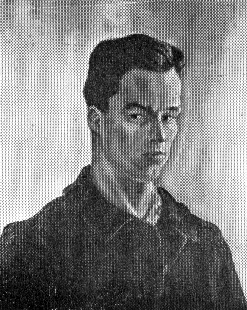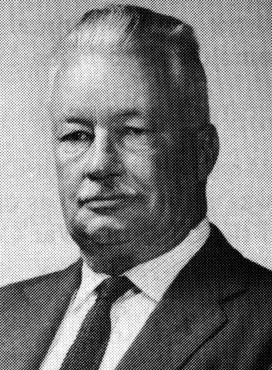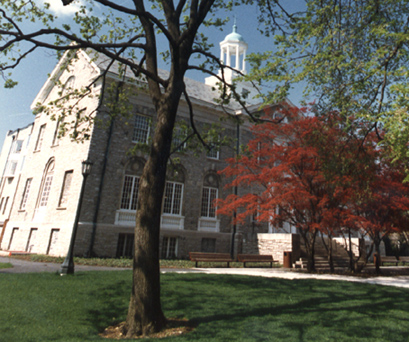
"Striking A Pose - 1958"

Karen Dee Brandenburg was a resident of Baltimore, Maryland. Attaining a Bachelor of Arts degree from the College, Ms. Brandenburg was a sister of the Pi Beta Phi sorority and an active member of the Dickinson campus. Some of her activities included the Mermaid Players theater, the choir, and working on the staffs of the Dickinsonian (the college newspaper) and the Microcosm (the college yearbook). Alumni records as of 1993 indicated that Ms. Brandenburg was now Mrs. Karen B. McCreary of Ashland, Virginia. In Ashland, she was the manager of the Dew Real Estate office.

Self portrait of Professor Pusey drawn in 1920's |

John Pusey in his Dickinson years |
John Drake Pusey was in 1958, the Artist in Residence with the rank of Associate Professor. Professor Pusey was also a Lieutenant Colonel of the United States Army Corps of Engineers, and was a renowned painter, draughtsman, muralist, and designer. Council Bluffs, Iowa, native, an Episcopalian and member of the Phi Delta Theta fraternity, came to Dickinson College with a wealth of experience in the fine arts and a extensive educational and artistic background. Professor Pusey graduated from Northwestern University and subsequently attended the Chicago Art Institute and the Yale University School of Fine Arts. He had further gone on to study abroad in France at the Louvre, the Luxembourg Art Museum, and the Prado in Spain. While in Europe, Pusey gave many exhibitions of his art and met his future wife Margaret Jarvis, who was studying at the Sorbonne. The two were married in Paris in 1926.
Returning to the United States, Pusey found employment in a number of areas. In the 1930's, he was commissioned by pharmaceutical and biomedical research pioneer Eli Lilly to paint murals to decorate his home. These murals were renowned for their design and use of color as well as their meaning to both the artist and Mr. Lilly. In 1938, the San Francisco World's Fair hired Pusey to paint murals and oversee the artistic side of the event. John Pusey also found employment at Universal Motion Picture Studios in Hollywood as an assistant art director. With the approach of the Second World War, Pusey enlisted in the United States Army and served in both the European theater and the Korean War in the early 1950's. Pusey's main concentration in the army was that of a camouflage artist and inventing new ways to hide Allied movements from enemy observation.
Pusey returned to the United States and once again found himself actively pursued for his artistic talents. He was hired to paint murals for many public and private institutions, including the Des Moines Library and Iowa State College. Pusey was then hired for the 185th academic year at Dickinson College to replace Joseph Spehhard as Artist in Residence. Mr. Spehhard was on his way to Paris on a Guggenheim fellowship, to further his artistic career. Lieutenant Colonel Pusey was given the title of Associate Professor and his classes became some of the most popular on campus. In addition to his regular teaching duties, Professor Pusey offered evening art classes to adults for a $20 fee. From November 5-23, 1960, Dickinson College held a Retrospective Exhibition of Pusey's work in the Bosler Hall Art Gallery. His first Carlisle exhibition was a success. Pusey also began work on a massive mural commemorating the sacrifice of the men and women of the Second World War, at the U.S. Army War College, Carlisle Barracks. After finishing the mural, Pusey retired from the U.S. Army in January of 1965. Prof. Pusey died in his sleep on September 2, 1966 and was buried in the National Cemetery in Gettysburg. He was survived by his wife Margaret, daughter Anne Morgan Willmarth, and son John Jarvis. His brother Dr. Nathan Pusey was President of Harvard at the time.

Weiss Center, modern home of the Fine Arts
Department
Under the leadership of educators like Professor John Pusey, the Fine Arts department at Dickinson College grew from its beginnings in Bosler Hall and East College in make-do studios to an impressive major at the College. In 1958, there were ten classes offered studying periods such as Classical Art, Modern Art, and the Fundamentals of Painting and Design. Today, in 1998, Dickinson College offers thirty-nine courses and numerous internships to its students in a variety of subjects. The Emil R. Weiss Center for the Arts, built in 1983, offers wonderful, modern work areas for the students of Dickinson College and will continue to provide a home for the study of the fine arts well into the next century.
Timothy Ferguson